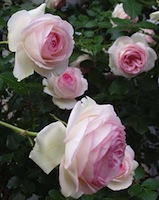- Mother’s Day Recipes You Can Make with Flowers - May 9, 2019
- Celebrating Flowers and Culture at the Shinnyo-en Lantern Floating Ceremony - March 29, 2018
- Give Easter Lilies This Spring - March 22, 2018
After literally thousands of years of cultivation, the wild, five-petaled rose found growing on the hillsides of Asia and Europe has been transformed into the botanical behemoth it is today. While progressive breeding and specific selection has given the rose both girth and consistency, many have found that those features have come at a cost to both fragrance and form. Fortunately, roses live longer than most people and many an old bush has been found growing in churchyards and along roadsides. Gardeners and florist have propagated these vintage blooms into a new market, calling them antique roses.
Imported primarily from Ecuador and Colombia, the roses of today have won a genetic victory for their close relationship with humans, making them the most popular and recognizable cut flower in the world. They have been bred naturally, though chosen artificially, for specific traits that make them more easily shipped and longer-lasting. This intentional breeding is called hybridization and has resulted in a wide spectrum of colors ranging from deep red to pure white and a variety of sizes and forms. Called hybrid tea roses (Rosa x hybrida), the selection of these at your local florists can be almost endless. By contrast, antique roses are those that were around prior to the mid-1800’s and display characteristics of older rose species and cultivars. The oldest know rose breed, the Apothecary’s Rose (Rosa gallica officinals), for example has strong, alluring fragrance and deep, rich color while being wider and more open than typical hybrids. Softer, muted colors and stronger scents are two characteristics prized by collectors and connoisseurs of these blooms.
With healthy foliage and a surprisingly strong disease resistance, antique roses are seeing a resurgence in the landscape, with several different varieties suitable for a range of USDA hardiness zones. Florist, too, are aware of a new interest in the vintage look of these voluptuous blooms and can usually order them with about one week’s notice. Mixed with flowering branches in an antique vase or tied together in a wedding bouquet, just a few stems of these breathtaking beauties will pay homage to a time gone by while adding a lovely scent and ardent look to any arrangement.
One of the best features of antique roses are the unique names many go by and the stories that come with them. The familial David Austin roses, named for the man who began to breed and popularize many of the antique roses on the market today, come with names like “Constance Spry” and “Chianti”. The Damask group of roses come in various hues and are said to have been brought from the Middle East by returning Crusaders. There are so many different ones available today, and one sniff will have you quite glad they’ve been re-discovered. Whichever one you pick, it will be sure to have a story to tell.
While





